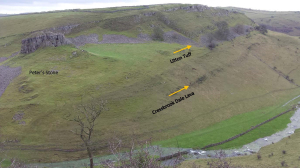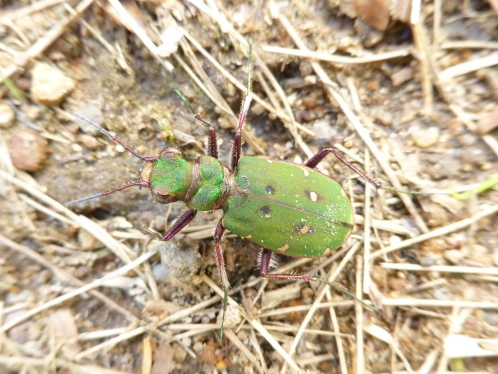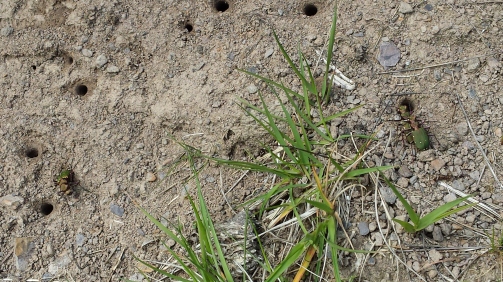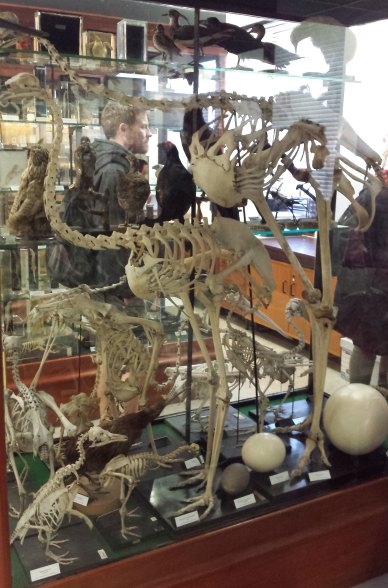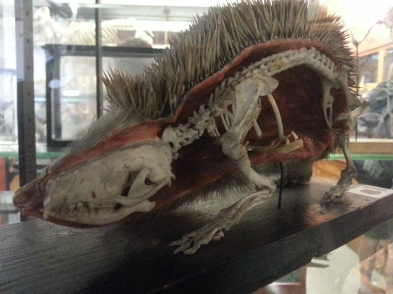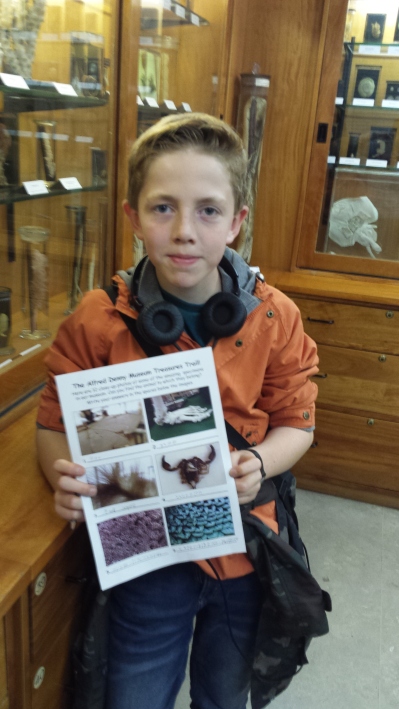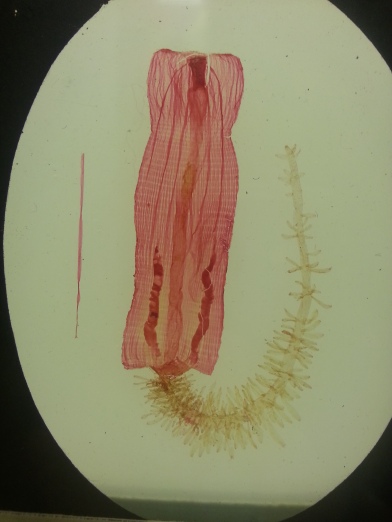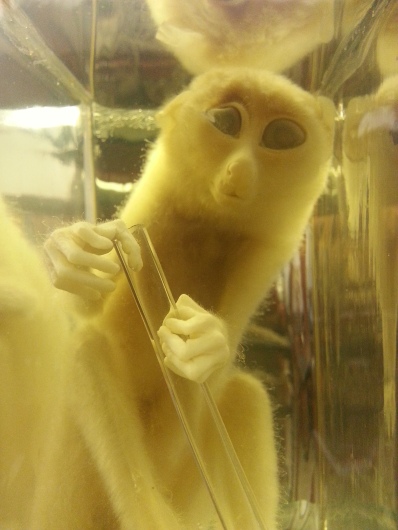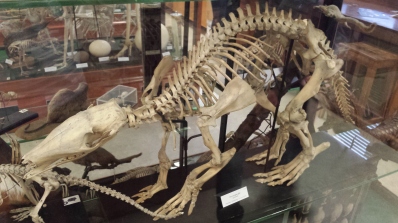Taking Wing: curating a collection of Venezuelan hawkmoths
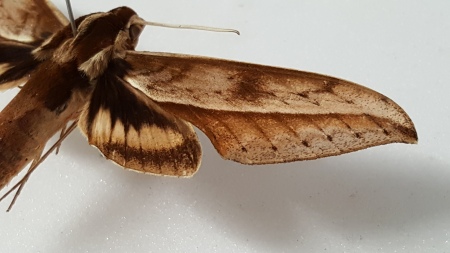 The following report has been prepared by Claire Miles, Honorary Curatorial Associate at The Manchester Museum.
The following report has been prepared by Claire Miles, Honorary Curatorial Associate at The Manchester Museum.
Manchester Museum purchased the Adams and Bernard collection of 300 Venezuelan Lepidoptera in April 1976. Since then, if a curious curator removed the lids from the cardboard boxes to peer at the ghostly silhouettes in their translucent paper packets, the lids were always replaced. Now, thanks to funding from the Natural Science Collections Association (NatSCA), part of this collection – around 175 hawkmoths – can be set out, identified, catalogued, and made useful. This blog is a brief summary of progress so far.
 Tantalising shapes – the moths in their paper packets.
Tantalising shapes – the moths in their paper packets.
In the paper packets, the hawkmoths lie with their wings folded together. With wingspans of up to 17 cm, setting the hawkmoths out will take up quite a bit of expensive storage space. Thanks to the NatSCA funding, the…
View original post 748 more words
Signs of life
Teeth. Feel your teeth with your tongue. Bite together. Use your fingers to feel them through the skin of your face. Do you like your teeth? Do you like the way they shape your face? Or have you always hated them? Do you feel guilty about the state of them? Would you trust them with a toffee?
Much more than buried bones, our teeth are an obvious part of our everyday appearance and shape how we see ourselves and others, and they’re tied up with all sorts of emotions we can easily imagine and share.
The teeth in the picture belong to a young woman. They were found with her skeleton at Fin Cop, a hillfort overlooking Monsal Dale, and are now at Buxton Museum. Although she lived around 2,300 years ago, her teeth are instantly recognisable and familiar objects to us, and they can tell us something about her.
Only…
View original post 280 more words
Making faces
Arranging for the reconstruction of the faces of early Peak District people is part of a work-based project I’m completing at Buxton Museum. The Museum is supporting this aspect of my work towards the Associateship of the Museums Association (AMA).
This week two of the human skulls at Buxton Museum were scanned to see if these faces from the past can be reconstructed. This will help us tell their story in the new Wonders of the Peak gallery. One skull is of a young person found at Fin Cop Iron Age hillfort, dating from around 300 BCE. The second skull belongs to a man buried around 2000 years earlier at Liffs Low.
The scanning was carried out by Mark Roughley and Dr. Eilidh Ferguson from Face Lab Research Group at Liverpool John Moores University and it was absolutely fascinating watching them work.
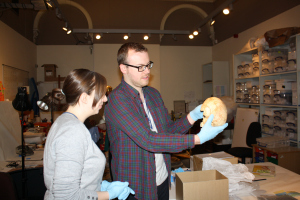 Mark and Eilidh make an initial assessment of the material.
Mark and Eilidh make an initial assessment of the material.
The research group at Face Lab provides expertise in analysing the bones of the skull and face. They use it to identify bodies in forensic investigation, and to make archaeological images of historical figures. Mark has a background in medical illustration and Eilidh in forensic anthropology and they were…
View original post 291 more words
Peak District Cave Lions!
This amazing Cave Lion foot is part of Jackson’s collection of animal bones from Hindlow near Buxton. We recently decanted it from its ‘Bone hole’ on the gallery where it lay along with other Hindlow remains of bison, horse, mammoth and wolf. Up close, it’s much more obvious what a large animal the Cave Lion was, much larger than present day lions. Going for a walk would be very different if these creatures still roamed the Peak District!
 Painting of lions at Chauvet Cavern, Southern France (museum replica). Wikimedia Commons
Painting of lions at Chauvet Cavern, Southern France (museum replica). Wikimedia Commons
![20160302_093659[1]](https://clairemilesblog.wordpress.com/wp-content/uploads/2016/03/20160302_0936591.jpg?w=726&h=408) Part of the Cave Lion material in store.
Part of the Cave Lion material in store.
Most of the Hindlow material is held in store because there is just too much of it to display. One of our expert volunteers Bente Loudon is working her way through assessing the material but previous research by Danielle Schreve (1997) on the Hindlow bones identified the presence of at least two lions. The bones include most of…
View original post 149 more words
Lava in the landscape
Some geology additions to the Buxton collections show volcanic events in the making of the local geology and gave a great excuse (as if one was needed!) to get out and explore to see where they came from. Some of the new specimens came from Cressbrook Dale, a dramatic limestone dale near Litton dominated at the top end by the imposing Peter’s Stone. At various times there’s been volcanic activity at a number of centres in the White Peak, which include Tunstead, Matlock, Alport and Eyam Edge. Not necessarily large volcanoes, these could have been areas of vents and fissures under the shallow sea that covered the area at the time, and from which lava flowed or material was ejected to produce falls of ash. This led to layers or intrusions of lava flow and tuff inside the limestone.
In Cressbrook Dale these outcrop where the rocks have been worn away.
The picture above shows the North end of Cressbrook Dale and another feature of…
View original post 206 more words
Butterflies and Moths
You’ll probably recognise many of these beautiful British butterflies. They come from two cabinets of butterflies and moths at Buxton Museum which, from the similarity of the labels, seem to be the collection of one person. The first cabinet contains eight drawers of moths, the second has six of moths and four of butterflies. The labels you can see in the photo normally live on the pins which hold the butterflies in place and show who collected them, when and where. The Camberwell Beauty in the bottom right is a rare migrant from Scandinavia and British sightings are usually on the East coast of England. Nowadays they sometimes escape or are released by breeders in this country. Unfortunately, this specimen had no information to say where it was collected. Many of the others are from Urmston, collected by C. S. Gleave in the 1930s and 40s and it would be great to find out more…
View original post 150 more words
A Hidden Herbarium
 Wood Anemone (Anemone nemorosa), Buxton 1884
Wood Anemone (Anemone nemorosa), Buxton 1884
My ears pricked up when I heard there was an Herbarium in the Museum’s collection stores, and I was off to investigate at the first opportunity. The Herbarium is a collection of 97 sheets of plant specimens. It gives a wonderful snapshot of the flora of the time, as well as a fascinating insight into the collector’s life and the times she lived in.
A sense of place
Almost half of the specimens are from the Peak District and the plants evoke, according to each locality, woodland shade, an intimate limestone dale, a wide slow-flowing river or panoramic moorland.
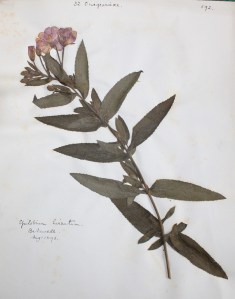 Greater Willow Herb, Epilobium hirsutum, Bakewell, 1893
Greater Willow Herb, Epilobium hirsutum, Bakewell, 1893
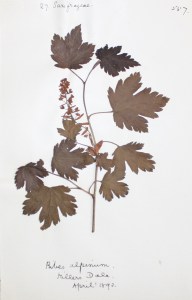 Alpine Currant, Ribes alpinum, Millers Dale, 1892
Alpine Currant, Ribes alpinum, Millers Dale, 1892
 Lousewort, Pedicularis sylvatica, Nr. Buxton, 1895.
Lousewort, Pedicularis sylvatica, Nr. Buxton, 1895.
There are also 14 sheets of mosses, totalling 50 different species, although sadly its not clear where most of these were collected.
A handwritten…
View original post 598 more words
Green Tigers!
Click on images for a closer view.
Walking up a steeply sloping track yesterday, we came across a large number (at least 20) Green Tiger Beetles (Cicindela campestris) around a sunny, dry earth bank. They were very active, scurrying about and taking off in flight when disturbed, landing a short distance away, and were very eye-catching with metallic green bodies, purple legs and eyes and cream spots.
Looking close, we could see their long legs, large eyes, strong jaws and their long, sensory bristles, which all help them catch their prey of small invertebrates such as spiders and ants.
There were lots of round holes in the bank – the burrows where the beetles lay their eggs. As the larvae grow, they anchor themselves in the burrow with a spine on their back and lie in wait for small invertebrates. Although, these are the commonest Tiger Beetles in the UK, this was a new experience for us and fantastic to see them buzzing about in the sunshine.
References:
Chinery. M. (1993) Insects of Britain and Northern Europe. Harper Collins Publishers Ltd, London.
Chinery M. (2005) Complete guide to British insects. Harper Collins Publishers Ltd, London.
https://www.buglife.org.uk/bugs-and-habitats/green-tiger-beetle
http://www.wildlifetrusts.org/species/green-tiger-beetle
http://www.arkive.org/green-tiger-beetle/cicindela-campestris/
Barnard P.C. (2011) Royal Entomological Society Book of British Insects. Wiley-Blackwell
A look at the Alfred Denny Museum of Zoology
(Click on images to enlarge.)
If you’re looking for somewhere to while away an hour in Sheffield, I can highly recommend this collection of biological specimens at the Department of Animal and Plant Sciences at Sheffield University. It’s open to the public on the first Saturday of the month, when bookable hourly tours are run by student volunteers. Our group of about 10 were given a brief introduction by Zoology students Chloe and Merryl, then allowed to wander and ask questions.
There was no chance of getting bored given the small scale of the collection and the huge variety of specimens. My family (a 10 year old, a 2nd year university student and 3 parents, one a natural history/museum nut) found plenty to keep us all thoroughly occupied, interested and drawn from one cabinet to the next. For some visitors half an hour was plenty, while we had to be politely edged out of the door with the lure of a look at the Sorby slides when the hour was up!
The collection includes fish, reptiles, amphibians, birds, mammals and arthropods, represented by skeletons, spirit specimens, taxidermy and pinned insects. The specimens are arranged systematically by Phyla in the 15 cases and there’s a useful plan in the Museum Guide provided.
The room is not much longer than this, with cabinets around the walls too. These beautiful cabinets were transferred when the museum moved from its original location in Firth Court.
‘Half-specimens’ show the animal’s inner workings.
Observational skills were encouraged.
Wonderful to see a Manitee skeleton.
Part of the amazingly preserved and unique collection of slides of marine organisms prepared by Henry Clifton Sorby in the early 1900s.
All the specimens are clearly identified by labels, but sadly we were told much of the information associated with them has been lost, so our guides couldn’t tell us much about where they came from, apart from a story about the porpoise being barrowed up from the fishmarket in Sheffield!
Although the museum was only opened to the public in 2012, it’s been a teaching resource for over 100 years and is used with undergraduate courses on biodiversity and evolution. As with most museum collections, what’s on show is a fraction of the whole and we were told further displays are in development. The museum’s curator is Prof. Tim Birkhead.
The department also runs a ‘Be a Scientist for the Day’ programme. This offers primary students the chance to work in the labs to find out what it’s like to be a real biologist and to explore the museum. There’s plenty of information about the collections on the Museum website, worth looking at before a visit.
‘Ugh! I don’t like the crinkly bits!’ Joe Young, age 10.


![20160317_154959[1]](https://clairemilesblog.wordpress.com/wp-content/uploads/2016/03/20160317_1549591.jpg?w=678&h=383)
